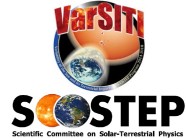Complex catalogue of high speed streams and geomagnetic storms during solar cycle 24
(Partially supported by) VarSITI Grant 2017
A complex catalog of the High Speed Streams (HSSs) produced by Coronal Holes (CHs) and their effects in terrestrial magnetosphere as geomagnetic storms for Solar Cycle (SC) 24, from 2009 to 2019 is presented here. The HSSs in the solar wind have a lot of definition given by different authors; the simplest is often the best: a large increase in the solar wind velocity lasting for several days. We selected as „high-speed stream” a solar wind flow having Δ V1 > 100 km/s that lasted for two days, where: Δ V1 is the difference between the largest 3-h mean plasma velocity for a day (V1) and the smallest three-hours (3-h) mean plasma velocity for the previous day (V0). The HSSs were determined using software developed by Ovidiu Mariș (Institute of Space Science) during a previous national collaboration (HELIOTER, Contract nr. 81-021/2007) and improved by our team (with special thanks to Daniela Lacatus și Alin Paraschiv), using C and IDL. We thank Ovidiu Mariș for making this software available to our team.
The first part of the catalog lists basic parameters of the high speed streams: start time (calendar date by year, month, and day), the initial (V0) and V1 – maximum velocity in the second day of the stream (km/s), Δt1 – time interval between V0 and V1 (in number of 3-h intervals), the maximum (Vmax) speed (in km/sec), the duration (in days), the gradient of the plasma velocity between the first two days – ΔV1 = V1-V0 , the maximum gradient of the HSS velocity – ΔVM = Vmax-V0, the intensity of the stream defined as I = ΔVmax × d, (d-duration of HSS) and, their solar CH (Coronal Holes) sources.
The main (dominant) polarity of the interplanetary magnetic field (IMF) during the streams is also mentioned in column 15 by “+” or “ –“ if it was positive or negative one, respectively. If the HSS passed over or was overimposed on a IMF magnetic boundary the case is also noted by “+/-” or “-/+”.
The second part of the catalog contains all geomagnetic storms (GS) having Dst minimum value less or equal to –30 nT (from minor to strong GS) associated to each HSS, by listing their Dst minimum value, the moment of this minimum given by the calendar date format: month, day and hour (mm:dd:hh), a description of its commencement (storm with sudden commencement – SSC). The minimum negative values of the southern component of the heliospheric magnetic field (Bz, in nT) registered just before or near to the minimum Dst values and its time (mm:dd:hh) is also included. In order to give a better estimate of the GS evolution and characteristics, our catalog also includes estimated values for the energy deposited in the magnetosphere from solar wind. These estimates are computed using the Akasofu parameter ε (Akasofu, 1981), integrated over the main phase of the geomagnetic storms and an improved version of this formula, EIN, given by Wang (Wang et al., 2014), noted by ΔWε and ΔW, respectively. The main phase of the storm is defined as the interval when Dst was clearly decreasing, considering that for moderate geomagnetic storms the initial phase can be long and include initial variations of the Dst index. Generally, one single geomagnetic storm is induced by a HSS. However, there are some cases when, during a complex HSS, two or even more (minor) geomagnetic storms are registered; in such cases, the parameters of the successive geomagnetic storms will appear on successive rows in catalog.
Recently many scientists have begun to use the SYM-H geomagnetic index instead of classic disturbance storm time index, Dst. The geomagnetic disturbance at mid-latitudes can be described in terms of longitudinally asymmetric (ASY) and symmetric (SYM) disturbances for both H and D components respectively, parallel and perpendicular to the dipole axis. Although there are some differences in the method of derivation, in the number and location of ground geomagnetic stations and in time resolution, the difference between Dst and SYM-H is only by a few nT. The main advantage is that SYM-H has 1-min time resolution compared to the 1-hour time resolution of Dst.
Acknowledgments:
The data used for compiling this catalog were taken from:
– GSFC/SPDF OMNIWeb interface at https://omniweb.gsfc.nasa.gov
– http://wdc.kugi.kyoto-u.ac.jp/aeasy/index.html
– http://www.solen.info/solar/coronal_holes.html; This report has been prepared by Jan Alvestad. It is based on the analysis of data from whatever sources are available at the time the report is prepared.
– http://spaceweather.com/; We denoted CH* a coronal hole observed using images from this site.
– http://www.obsebre.es/en/rapid (data available under “Creative Commons Attribution-NonCommercial 4.0 International License”)
We thank all of the above for making the data available.
We also acknowledge the support of VarSITI – SCOSTEP program (2014 – 2018).
HSS Data Use Policy: All publications based upon this catalog must contain the following footnote or acknowledgment: “This work utilises the HSS catalog issued by G. Mariș Muntean, D. Beșliu-Ionescu, V. Dobrică, managed by the Institute of Geodynamics of the Romanian Academy.”
For any other information regarding this catalog, please contact: gmaris ‘at’ geodin.ro.









